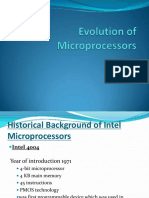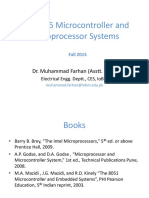0% found this document useful (0 votes)
15 views52 pagesModule 1
The document provides an overview of microprocessors and microcontrollers, detailing their components such as memory, input/output systems, control units, and arithmetic logic units. It traces the evolution of Intel microprocessors from the 4004 in 1971 to the Core i9 introduced in 2017, highlighting their specifications and advancements over time. Additionally, it discusses performance metrics and the significance of various CPU components in executing instructions and data processing.
Uploaded by
apayushpandey04Copyright
© © All Rights Reserved
We take content rights seriously. If you suspect this is your content, claim it here.
Available Formats
Download as PPTX, PDF, TXT or read online on Scribd
0% found this document useful (0 votes)
15 views52 pagesModule 1
The document provides an overview of microprocessors and microcontrollers, detailing their components such as memory, input/output systems, control units, and arithmetic logic units. It traces the evolution of Intel microprocessors from the 4004 in 1971 to the Core i9 introduced in 2017, highlighting their specifications and advancements over time. Additionally, it discusses performance metrics and the significance of various CPU components in executing instructions and data processing.
Uploaded by
apayushpandey04Copyright
© © All Rights Reserved
We take content rights seriously. If you suspect this is your content, claim it here.
Available Formats
Download as PPTX, PDF, TXT or read online on Scribd
/ 52


























































































